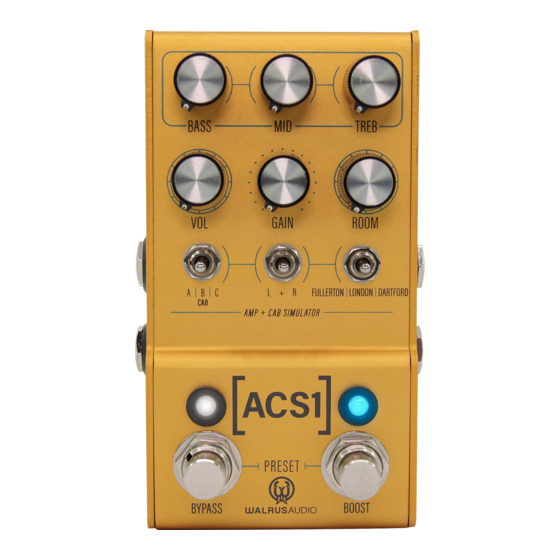
Walrus Audio Mako Series Manual
Hide thumbs
Also See for Mako Series:
- Instruction manual (7 pages) ,
- Instruction manual (13 pages) ,
- Instruction manual (12 pages)
Advertisement
The [ACS1]™ is an amplifier and speaker cab simulator delivering the sound and feel of world-
class amplifiers, complimentary speaker cabinets created by Tone Factor, and controllable
room size. With the ACS1, players have expansive options to deliver their tone whether it's on
stage, in the studio, or practicing at home. Simple controls, stereo in and out, onboard presets,
and MIDI support make the ACS1 an immeasurable tool in any guitarist's arsenal.
*The use of an isolated power supply is recommended for powering all Walrus Audio Pedals.
Email help@walrusaudio.com to talk with a real live human about your Walrus gear!
9 volt DC, Center Negative • 300mA min*
Daisy chain power supplies are not recommended.
Got questions or need a repair?
This product comes with a limited lifetime warranty.
Click Here
AMP MODELS
Amp Switch (Fullerton | London | Dartford) - The Amp switch selects
between one of three classic amp models built into the ACS1.
Designed from the ground up using a detailed physical modeling-based
simulation of the original circuity, each of the cascading triode/filtering
stages have been faithfully replicated creating complex tones, rich with
even harmonics and subtle intercomponent asymmetries/inconsistencies.
The power amp staging has been highly biased to retain plenty of dynamic
warmth and headroom during Class A behavior at low gains, shifting into
an increased sensitivity and overdrive in Class AB saturation through to
complete Valve breakup at maximum.
Fullerton: Inspired by the classically snappy and clear Fender® Deluxe
Reverb. Clean headroom that blooms into the fat, rich breakup that
players have come to love over the years.
London: Inspired by a 1962 Marshall® Bluesbreaker with a harmonically
rich, valve-driven breakup. Perfect for sustained lead notes with tons of
gain on tap and a punchy mid-ranged voicing.
Dartford: Inspired by the legendary and jangly tones from a 1960s Vox®
AC30 with all the bite and chime from the British Invasion. Higher gain
settings offer up plenty of saturation that represent the loudness and
punch of the original amp cranked.
for more info.
Advertisement
Table of Contents

Summary of Contents for Walrus Audio Mako Series
- Page 1 MIDI support make the ACS1 an immeasurable tool in any guitarist’s arsenal. 9 volt DC, Center Negative • 300mA min* *The use of an isolated power supply is recommended for powering all Walrus Audio Pedals. Daisy chain power supplies are not recommended.
- Page 2 CABS The cabs are broken into two groups of three. The “front” three are accessed by simply moving the Cab toggle switch to the desired position. The “back” three are accessed by holding down the bypass switch while moving the Cab toggle. To help make this more intuitive, we have laid these out based on the amp we like using them with, but there is no right or wrong.
- Page 3 CONTROLS Bass - The Bass knob shapes the low-end tone stack of the selected amp model. Turn up for a thicker sound and down to help tame muddy pickups. Mid - The Mid knob shapes the mid-range tone stack of the selected amp model.
- Page 4 PRESETS The ACS1 includes 128 total preset slots. The first three presets are accessible from the pedal using both stomp switches. All 128 are accessible via MIDI Program Change messages which are outlined in the MIDI section. • To recall a preset: Simply press both stomp switches at the same time to scroll through the three on-board presets - red, green, and blue then back to red.
- Page 5 GUITAR INPUTS AND OUTPUTS The ACS1 offers multiple input and output configurations and features true bypass circuity. • Mono In / Mono Out • Mono In / Stereo Out • Stereo In / Stereo Out Headphone Jack - The ACS1 features an on-board headphone output for quiet practicing.
- Page 6 MIDI PRESET MIDI PROGRAM CHANGE (PC) Green Blue Accessible via MIDI 3-127 * *preset LED will be white for all of these presets o MIDI CC – Most parameters on the ACS1 can be controlled via MIDI CC messages. The list below shows all applicable MIDI CC numbers and their associated parameters and control values.
- Page 7 GLOBAL PREFERENCES Factory Reset - Use the following procedure to restore the pedal to its factory settings. 1. Hold both stomp switches while applying power. 2. Continue holding both stomp switches for longer than 10 seconds. Initially, both LED’s will flash white. Keep holding both stomp switches until the bypass LED turns solid blue and the boost LED blinks blue.
- Page 8 TECHNICAL INFO Frequency Response: 20Hz To 20kHz Inputs: 2, 1/4” unbalanced TS Outputs: 2, 1/4” unbalanced TS USB Type Micro-B: For firmware updates and IR loading via walrusaudio.io Power Requirement: Isolated 9VDC, center-negative, 300mA minimum Size Including Knobs/Jacks: Height: 2.48” / 63.15mm Width: 2.9”...




Need help?
Do you have a question about the Mako Series and is the answer not in the manual?
Questions and answers